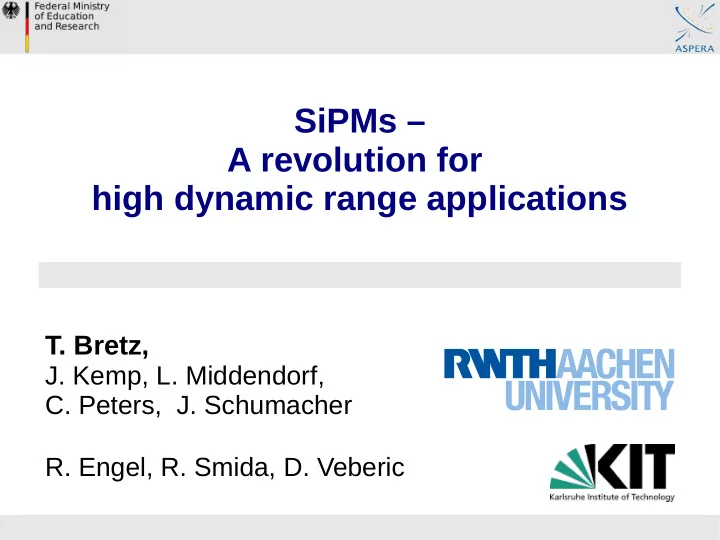

SiPMs – A revolution for high dynamic range applications T. Bretz, J. Kemp, L. Middendorf, C. Peters, J. Schumacher R. Engel, R. Smida, D. Veberic Thomas Bretz (RWTH Aachen University), Busan, South Korea, July 2017 1
Mass Product → high precision → low cost product Thomas Bretz (RWTH Aachen University), Busan, South Korea, July 2017 2
Pierre Auger – AugerPrime SSD Can SiPMs be used to read out the scintillator? Thomas Bretz (RWTH Aachen University), Busan, South Korea, July 2017 3
The SiPM optical module 2 SiPMs (sum) 2x 57,600 G-APDs Power via USB J. Schumacher, J. Kemp Temperature feedback 2 Lightguides 3 gain levels How identical are the two SiPMs? Is the binomial response understood? Thomas Bretz (RWTH Aachen University), Busan, South Korea, July 2017 4
High precision Geiger-mode Semi conductor photo sensors avalanche photo diode SiPM ~2µm 1 mm 50µm Example: Hamamatsu 1mm² Transistor in 2015: ~20nm(!) Credits: Hamamatsu Thomas Bretz (RWTH Aachen University), Busan, South Korea, July 2017 5
Single photon counting High precision → every avalanche (cell) releases similar charge 8pe 7pe 6pe 5pe 4pe 3pe 3pe 3pe 2pe 1pe Credits: Hamamatsu Thomas Bretz (RWTH Aachen University), Busan, South Korea, July 2017 6
Binomial counting process No. of cells Fraction of maximum signal No. detected photons = No. of cells No. of impinging photons · PDE / number of cells Thomas Bretz (RWTH Aachen University), Busan, South Korea, July 2017 7
Resolution decreases → Dynamic range increases! Fraction of maximum signal No. of impinging photons · PDE / number of cells → Systematics become dominant! → How identical are two devices of the same type? Thomas Bretz (RWTH Aachen University), Busan, South Korea, July 2017 8
Compare two devices of same type Dark box LED SiPMs ~10ns pulse Rotating two SiPMs around a symmetry axis → After 180°, both SiPMs see the same light yield Thomas Bretz (RWTH Aachen University), Busan, South Korea, July 2017 9
Charge state for measurement → Measurement close to saturation of sensor Thomas Bretz (RWTH Aachen University), Busan, South Korea, July 2017 10
Determine systematic error Fit: f ( φ ) = C + A · sin(φ - φ 0 ) LED LED C = 0.7% ± 0.4% (syst.) φ = φ 0 C = 0 C Offset (syst. diff. of sensors) A Amplitude (syst. diff. of light distribution) φ 0 Phase (setup dependent) Thomas Bretz (RWTH Aachen University), Busan, South Korea, July 2017 11
Determine systematic error Fit: f ( φ ) = C + A · sin(φ - φ 0 ) LED LED C = 0.7% ± 0.4% (syst.) φ = φ 0 Consistent with 0.6% difference in gain due to different break- down voltage Thomas Bretz (RWTH Aachen University), Busan, South Korea, July 2017 12
Determine systematic error Fit: f ( φ ) = C + A · sin(φ - φ 0 ) LED LED C = 0.7% ± 0.4% (syst.) φ = φ 0 Consistent with 0.6% difference in gain due to different break- down voltage → Two SiPMs of the same type are identical if operated at identical over-voltage Thomas Bretz (RWTH Aachen University), Busan, South Korea, July 2017 13
The setup (Two SSD) Selected high linearity Wavelength shifting fibers Experimental setup at KIT Thomas Bretz (RWTH Aachen University), Busan, South Korea, July 2017 14
The raw signal Depends on history Is it understood? Thomas Bretz (RWTH Aachen University), Busan, South Korea, July 2017 15
Measured trace ● Measured trace is a convolution of the single-pe pulse Measured trace and the hit distribution Amplitude / mV·0.8ns Hit distribution ☼ single-pe Single PE Thomas Bretz (RWTH Aachen University), Busan, South Korea, July 2017 16
Deconvolution Amplitude, PE / 0.16ns Measured signal Deconvolution Hit distribution Thomas Bretz (RWTH Aachen University), Busan, South Korea, July 2017 17
Hit distribution ● Deconvolve measured signal into hit distribution PE / 0.16ns Hit distribution Thomas Bretz (RWTH Aachen University), Busan, South Korea, July 2017 18
Simulating the SiPM response ● Deconvolve measured signal into hit distribution ● Feed the trace into a SiPM simulation PE / 0.16ns Simulation input Simulation output Thomas Bretz (RWTH Aachen University), Busan, South Korea, July 2017 19
Matching the simulation output ● Deconvolve measured signal into hit distribution PE / 0.16ns, Photons / 0.16ns ● Feed the trace into a SiPM simulation Simulation input ● Scale simulation Simulation output input until single-pe trace and simulation output match Thomas Bretz (RWTH Aachen University), Busan, South Korea, July 2017 20
The raw signal Thomas Bretz (RWTH Aachen University), Busan, South Korea, July 2017 21
The corrected signal Thomas Bretz (RWTH Aachen University), Busan, South Korea, July 2017 22
The corrected signal ~ x3 ~5% Thomas Bretz (RWTH Aachen University), Busan, South Korea, July 2017 23
Comparing two SiPM modules SiPM 1 / SiPM 2 vs. PMT SiPM 1 vs. SiPM 2 → 2 nd SiPM module shows identical response Thomas Bretz (RWTH Aachen University), Busan, South Korea, July 2017 24
Conclusion ● Largest systematic uncertainty is the single-pe pulse (shape and amplitude) ● Simulation still under investigation ● Further measurements are foreseen → Two devices of the same type are identical within the precision of the applied over-voltage! → Proper processing increases the dynamic range significantly! Thomas Bretz (RWTH Aachen University), Busan, South Korea, July 2017 25
Recommend
More recommend